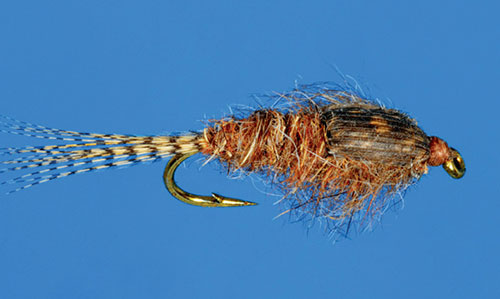TF’s Hares Ear Clinger Nymph
By Ted Fauceglia
Translated by Carl Wuebben
There is some sporadic mayfly activity that needs to be addressed. Lesser members of the heptageniidae family of mayflies hatch throughout the summer and while the adults (light Cahill look- alikes) hatch sporadically, their hatches are sparse and have rarely induced more than an occasional “rise”. There are however, enough heptageniidae nymphs present to warrant a nymph pattern that has annually worked for me as a “searching “fly. Heptageniidae nymphs are known as clingers. Measuring from 12 to 16 millimeters long they have flattened bodies with broad, blunt heads and muscular, spiderlike legs. Their strong legs and three long tails enable them to freely navigate in fast water where they live and flourish. Their colors range from a light to dark mottled tannish red-brown. The hare’s ear nymph is a staple in my nymph collection and easily one of the most productive all-purpose go-to nymphs that I fish. But just in case the trout get a bit selective and fickle, alter the fly just a little and tie up a couple TF’s hares ear clinger nymphs.
PATTERNHOOK - Tiemco 5262, sizes #12 to #16
THREAD - Camel 8/0 (70 denier) uni-thread
TAILS - Lemon wood duck Brest feather
ABDOMEN - A mixture that’s three parts #4 hareline hare’s ear plus dub and one part rusty brown wapsi SLF (synthetic living fiber) squirrel dubbing
WINGCASE - dark brown wild turkey quill
LEGS - Picked out dubbing on each side of the wing case
HEAD - Camel 8/0 (70 denier) uni thread
TIP - Treat the turkey feather with softtex or other feather treatment before you start tying and let it dry overnightHOW TO TIE
- Debarb hook - Mount hook in vice, start thread in at about mid shank then grab a small bunch of lemon wood duck breast feather fibers (about 12 or so fibers) and tie on top of the hook shank hanging out from the bend of the hook (about ¾ of the hook shank long) just make sure it stays on top by pinching the fibers down on the hook shank as you wrap your thread down to hold it in place
- Take your three parts #4 hareline hares ear plus dub and one part rusty brown wapsi SLF (synthetic living fibers) squirrel dubbing and mix together by pulling and putting back together then doing the same till it looks well blended.
- Now either twist a dubbing noodle onto the thread or use a dubbing loop with a dubbing loop tool but not too much you can add more as needed then wrap a tapered abdomen small to the rear and fatter at the middle then thin to the front thorax area (old cigar shape). But stop at mid shank first so you can do the next step (you may need to remove any extra dubbing at this time)
- Now grab a hunk of dark brown turkey quill (see tip in pattern part) about the width of the thickest part of the dubbed body then remove a few fibers and you should have a wing case just a little bit smaller than halfway over the side. Now with the shiny side facing down (top of feather) and the tips facing to the bend of the hook, tie down the fibers on the bare hook shank then bring your thread back to the mid shank area where you stopped your dubbing and now dub another noodle and wrap it forward toward the eye of the hook ( start the wraps tight up against the rear half of the body so you have no gaps between the two sections) but leaving a space to tie down the turkey fibers and make a head.
- Now using your bodkin to help you fold over the turkey fibers (be gentle you don’t want to have the fibers separate from each other) fold it forward and tie off behind the eye of the hook but don’t forget to leave a space for the head. Clip the tag end of the turkey fibers.
- Form a small head then whip finish and clip your thread, apply a small dab of head cement to the head then on each side and with your bodkin pick out a few fibers from the dubbing but only on the thorax sides. This will be the legs but be careful to not ruin the wing case or pull out too much.
TIE UP A DOZEN OR TWO – AND GO FISHING*** But remember to practice C.P.R. (CATCH – PICTURE – RELEASE)


